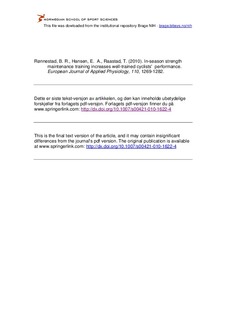| dc.contributor.author | Rønnestad, Bent R. | |
| dc.contributor.author | Hansen, Ernst Albin | |
| dc.contributor.author | Raastad, Truls | |
| dc.date.accessioned | 2011-08-19T06:51:17Z | |
| dc.date.available | 2011-08-19T06:51:17Z | |
| dc.date.issued | 2010-08-27 | |
| dc.identifier | Seksjon for fysisk prestasjonsevne / Department of Physical Performance | |
| dc.identifier.citation | European Journal of Applied Physiology. 2010, 110(6), 1269-1282 | en_US |
| dc.identifier.issn | 1439-6319 | |
| dc.identifier.uri | http://hdl.handle.net/11250/170841 | |
| dc.description | I Brage finner du siste tekst-versjon av artikkelen, og den kan inneholde ubetydelige forskjeller fra forlagets pdf-versjon. Forlagets pdf-versjon finner du på www.springerlink.com: http://dx.doi.org/10.1007/s00421-010-1622-4 / In Brage you'll find the final text version of the article, and it may contain insignificant differences from the journal's pdf version. The original publication is available at www.springerlink.com: http://dx.doi.org/10.1007/s00421-010-1622-4 | en_US |
| dc.description.abstract | We investigated the effects of strength maintenance training on thigh muscle cross-sectional area (CSA), leg strength, determinants of cycling performance, and cycling performance. Well-trained cyclists completed either (1) usual endurance training supplemented with heavy strength training twice a week during a 12-week preparatory period followed by strength maintenance training once a week during the first 13 weeks of a competition period (E + S; n = 6 [♂ = 6]), or (2) usual endurance training during the whole intervention period (E; n = 6 [♂ = 5, ♀ = 1]). Following the preparatory period, E + S increased thigh muscle CSA and 1RM (p < 0.05), while no changes were observed in E. Both groups increased maximal oxygen consumption and mean power output in the 40-min all-out trial (p < 0.05). At 13 weeks into the competition period, E + S had preserved the increase in CSA and strength from the preparatory period. From the beginning of the preparatory period to 13 weeks into the competition period, E + S increased peak power output in the Wingate test, power output at 2 mmol l−1 [la−], maximal aerobic power output (W max), and mean power output in the 40-min all-out trial (p < 0.05). The relative improvements in the last two measurements were larger than in E (p < 0.05). For E, W max and power output at 2 mmol l−1 [la−] remained unchanged. In conclusion, in well-trained cyclists, strength maintenance training in a competition period preserved increases in thigh muscle CSA and leg strength attained in a preceding preparatory period and further improved cycling performance determinants and performance. | en_US |
| dc.language.iso | eng | en_US |
| dc.publisher | Springer-Verlag | en_US |
| dc.subject | adult | en_US |
| dc.subject | athletes | en_US |
| dc.subject | athletic performance | en_US |
| dc.subject | bicycling | en_US |
| dc.subject | body weight | en_US |
| dc.subject | female | en_US |
| dc.subject | humans | en_US |
| dc.subject | male | en_US |
| dc.subject | muscle strength | en_US |
| dc.subject | anatomy & histology | en_US |
| dc.subject | muscle, skeletal | en_US |
| dc.subject | physical endurance | en_US |
| dc.subject | physical fitness | en_US |
| dc.subject | resistance training | en_US |
| dc.subject | respiratory function tests | en_US |
| dc.subject | seasons | en_US |
| dc.subject | thigh | en_US |
| dc.subject | physiology | en_US |
| dc.subject | methods | en_US |
| dc.title | In-season strength maintenance training increases well-trained cyclists’ performance | en_US |
| dc.type | Journal article | en_US |
| dc.type | Peer reviewed | en_US |
| dc.subject.nsi | VDP::Mathematics and natural science: 400::Basic biosciences: 470 | en_US |
| dc.source.pagenumber | 1269-1282 | en_US |
